Page 2474 of 4500
Fig. 44: Wiring Diagram - Stop Light Switch Circuit Malfunction
Courtesy of TOYOTA MOTOR SALES, U.S.A., INC.
INSPECTION PROCEDURE
1.READ VALUE ON HAND-HELD TESTER
a. Connect the han
d-held tester to the DLC3.
Page 2475 of 4500
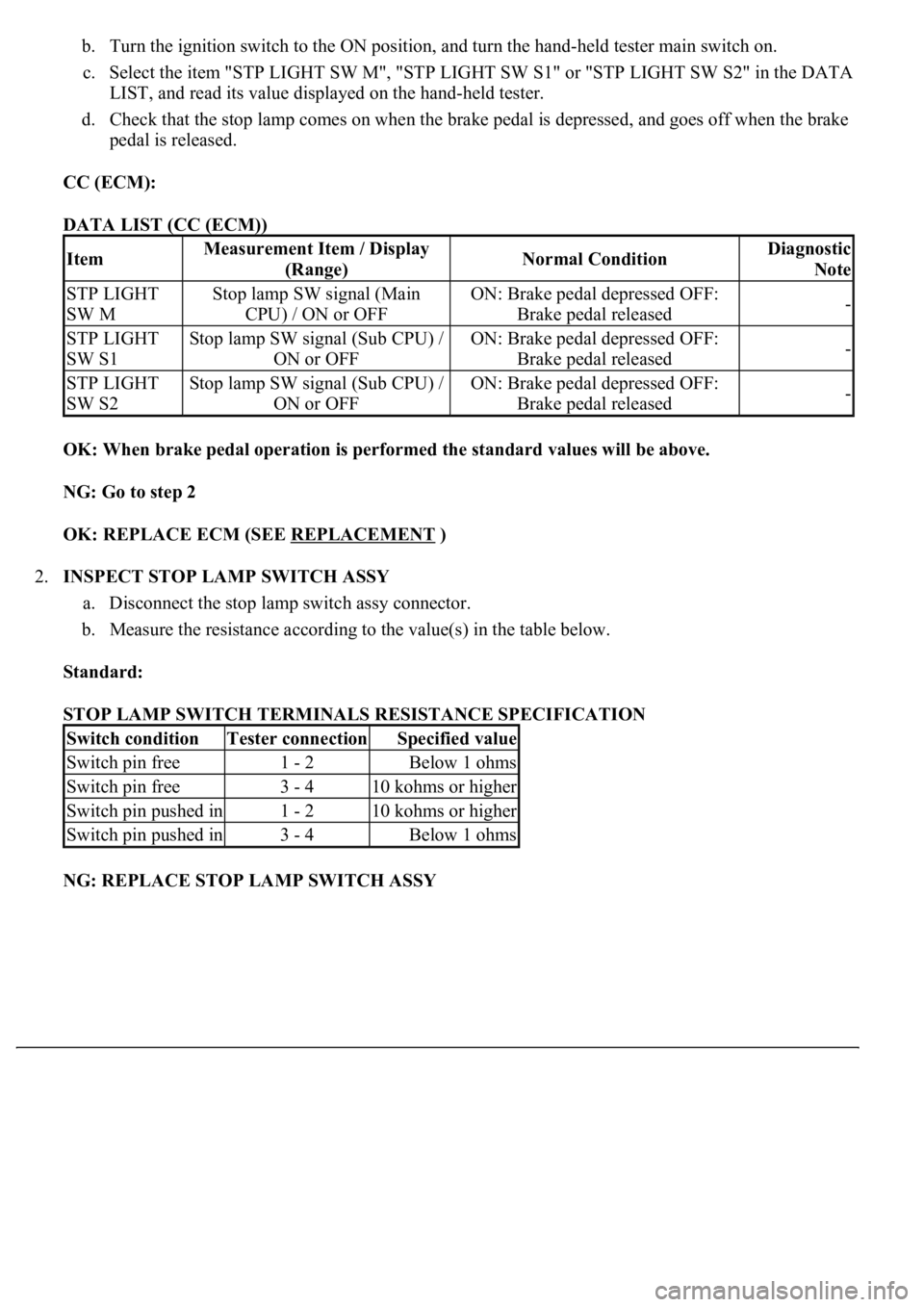
b. Turn the ignition switch to the ON position, and turn the hand-held tester main switch on.
c. Select the item "STP LIGHT SW M", "STP LIGHT SW S1" or "STP LIGHT SW S2" in the DATA
LIST, and read its value displayed on the hand-held tester.
d. Check that the stop lamp comes on when the brake pedal is depressed, and goes off when the brake
pedal is released.
CC (ECM):
DATA LIST (CC (ECM))
OK: When brake pedal operation is performed the standard values will be above.
NG: Go to step 2
OK: REPLACE ECM (SEE REPLACEMENT
)
2.INSPECT STOP LAMP SWITCH ASSY
a. Disconnect the stop lamp switch assy connector.
b. Measure the resistance according to the value(s) in the table below.
Standard:
STOP LAMP SWITCH TERMINALS RESISTANCE SPECIFICATION
NG: REPLACE STOP LAMP SWITCH ASSY
ItemMeasurement Item / Display
(Range)Normal ConditionDiagnostic
Note
STP LIGHT
SW MStop lamp SW signal (Main
CPU) / ON or OFFON: Brake pedal depressed OFF:
Brake pedal released-
STP LIGHT
SW S1Stop lamp SW signal (Sub CPU) /
ON or OFFON: Brake pedal depressed OFF:
Brake pedal released-
STP LIGHT
SW S2Stop lamp SW signal (Sub CPU) /
ON or OFFON: Brake pedal depressed OFF:
Brake pedal released-
Switch conditionTester connectionSpecified value
Switch pin free1 - 2Below 1 ohms
Switch pin free3 - 410 kohms or higher
Switch pin pushed in1 - 210 kohms or higher
Switch pin pushed in3 - 4Below 1 ohms
Page 2483 of 4500
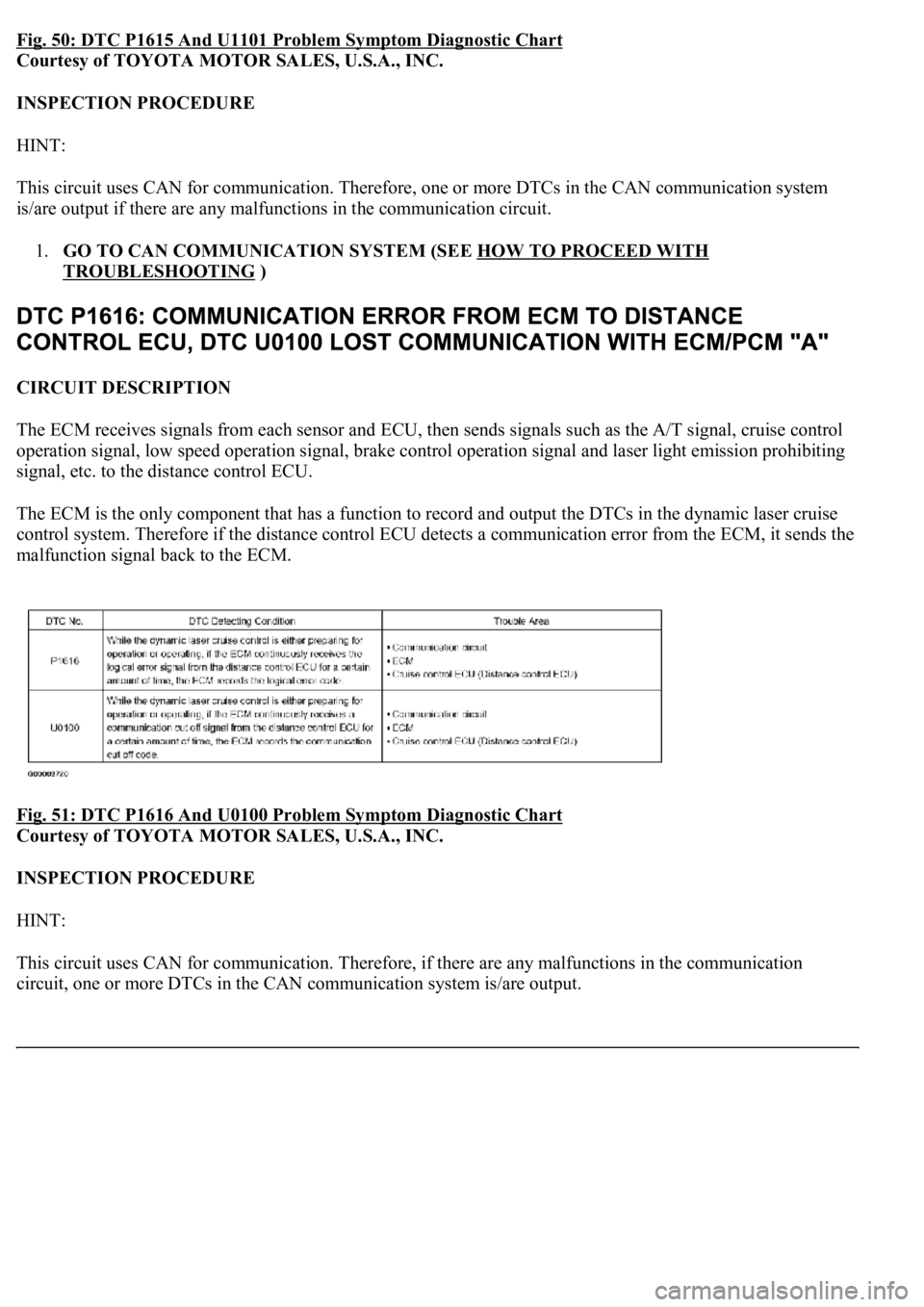
Fig. 50: DTC P1615 And U1101 Problem Symptom Diagnostic Chart
Courtesy of TOYOTA MOTOR SALES, U.S.A., INC.
INSPECTION PROCEDURE
HINT:
This circuit uses CAN for communication. Therefore, one or more DTCs in the CAN communication system
is/are output if there are any malfunctions in the communication circuit.
1.GO TO CAN COMMUNICATION SYSTEM (SEE HOW TO PROCEED WITH
TROUBLESHOOTING )
CIRCUIT DESCRIPTION
The ECM receives signals from each sensor and ECU, then sends signals such as the A/T signal, cruise control
<005200530048005500440057004c0052005100030056004c004a00510044004f000f0003004f0052005a0003005600530048004800470003005200530048005500440057004c0052005100030056004c004a00510044004f000f0003004500550044004e00
480003004600520051005700550052004f0003005200530048[ration signal and laser light emission prohibiting
signal, etc. to the distance control ECU.
<0037004b004800030028002600300003004c005600030057004b0048000300520051004f005c000300460052005000530052005100480051005700030057004b004400570003004b0044005600030044000300490058005100460057004c00520051000300
57005200030055004800460052005500470003004400510047[ output the DTCs in the dynamic laser cruise
control system. Therefore if the distance control ECU detects a communication error from the ECM, it sends the
malfunction signal back to the ECM.
Fig. 51: DTC P1616 And U0100 Problem Symptom Diagnostic Chart
Courtesy of TOYOTA MOTOR SALES, U.S.A., INC.
INSPECTION PROCEDURE
HINT:
This circuit uses CAN for communication. Therefore, if there are any malfunctions in the communication
circuit, one or more DTCs in the CAN communication system is/are output.
Page 2484 of 4500
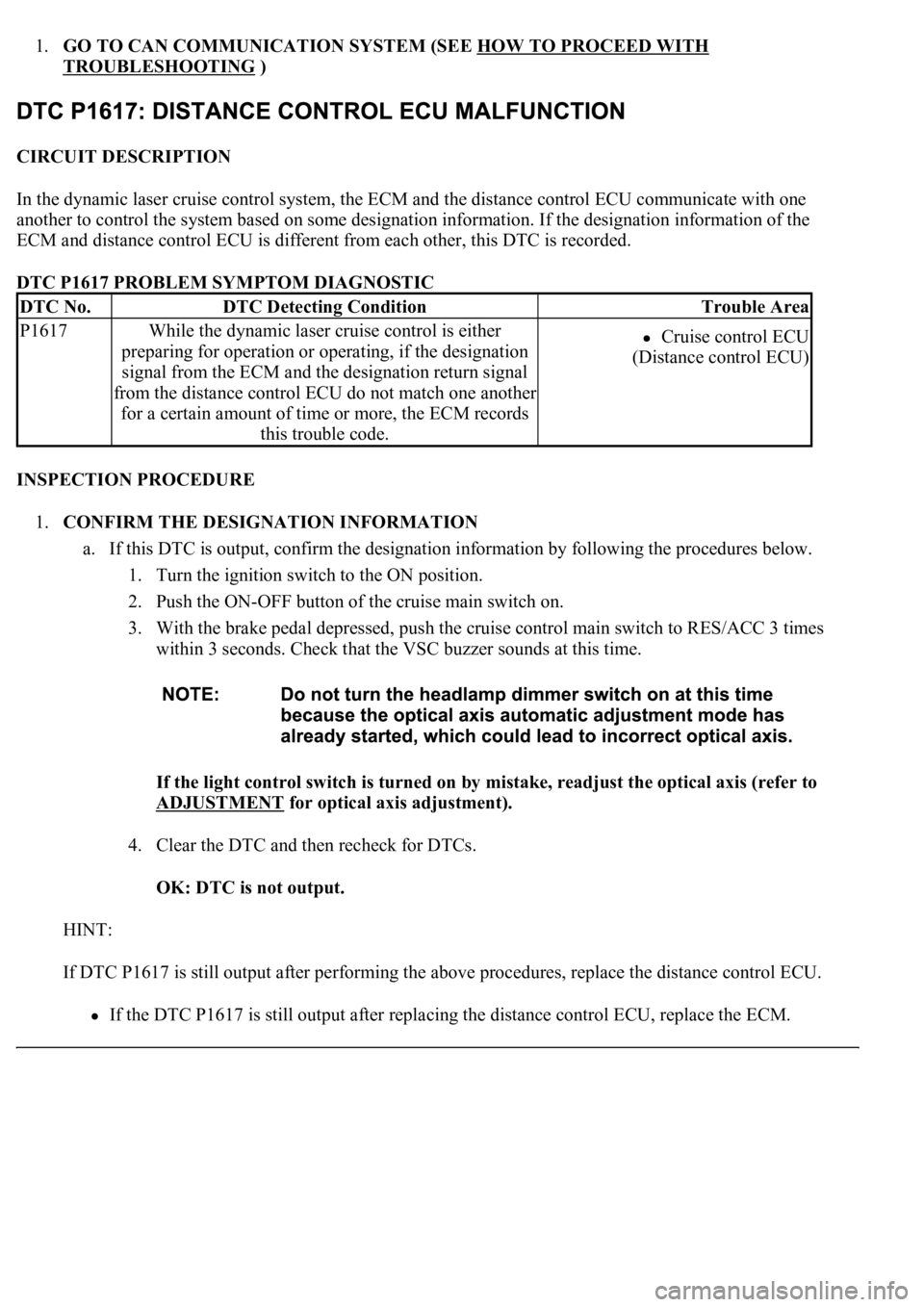
1.GO TO CAN COMMUNICATION SYSTEM (SEE HOW TO PROCEED WITH
TROUBLESHOOTING )
CIRCUIT DESCRIPTION
In the dynamic laser cruise control system, the ECM and the distance control ECU communicate with one
another to control the system based on some designation information. If the designation information of the
ECM and distance control ECU is different from each other, this DTC is recorded.
DTC P1617 PROBLEM SYMPTOM DIAGNOSTIC
INSPECTION PROCEDURE
1.CONFIRM THE DESIGNATION INFORMATION
a. If this DTC is output, confirm the designation information by following the procedures below.
1. Turn the ignition switch to the ON position.
2. Push the ON-OFF button of the cruise main switch on.
3. With the brake pedal depressed, push the cruise control main switch to RES/ACC 3 times
within 3 seconds. Check that the VSC buzzer sounds at this time.
If the light control switch is turned on by mistake, readjust the optical axis (refer to
ADJUSTMENT
for optical axis adjustment).
4. Clear the DTC and then recheck for DTCs.
OK: DTC is not output.
HINT:
If DTC P1617 is still output after performing the above procedures, replace the distance control ECU.
If the DTC P1617 is still output after replacing the distance control ECU, replace the ECM.
DTC No.DTC Detecting ConditionTrouble Area
P1617While the dynamic laser cruise control is either
<005300550048005300440055004c0051004a00030049005200550003005200530048005500440057004c005200510003005200550003005200530048005500440057004c0051004a000f0003004c004900030057004b00480003004700480056004c004a00
5100440057004c005200510003[
signal from the ECM and the designation return signal
from the distance control ECU do not match one another
for a certain amount of time or more, the ECM records
this trouble code.Cruise control ECU
(Distance control ECU)
Page 2486 of 4500
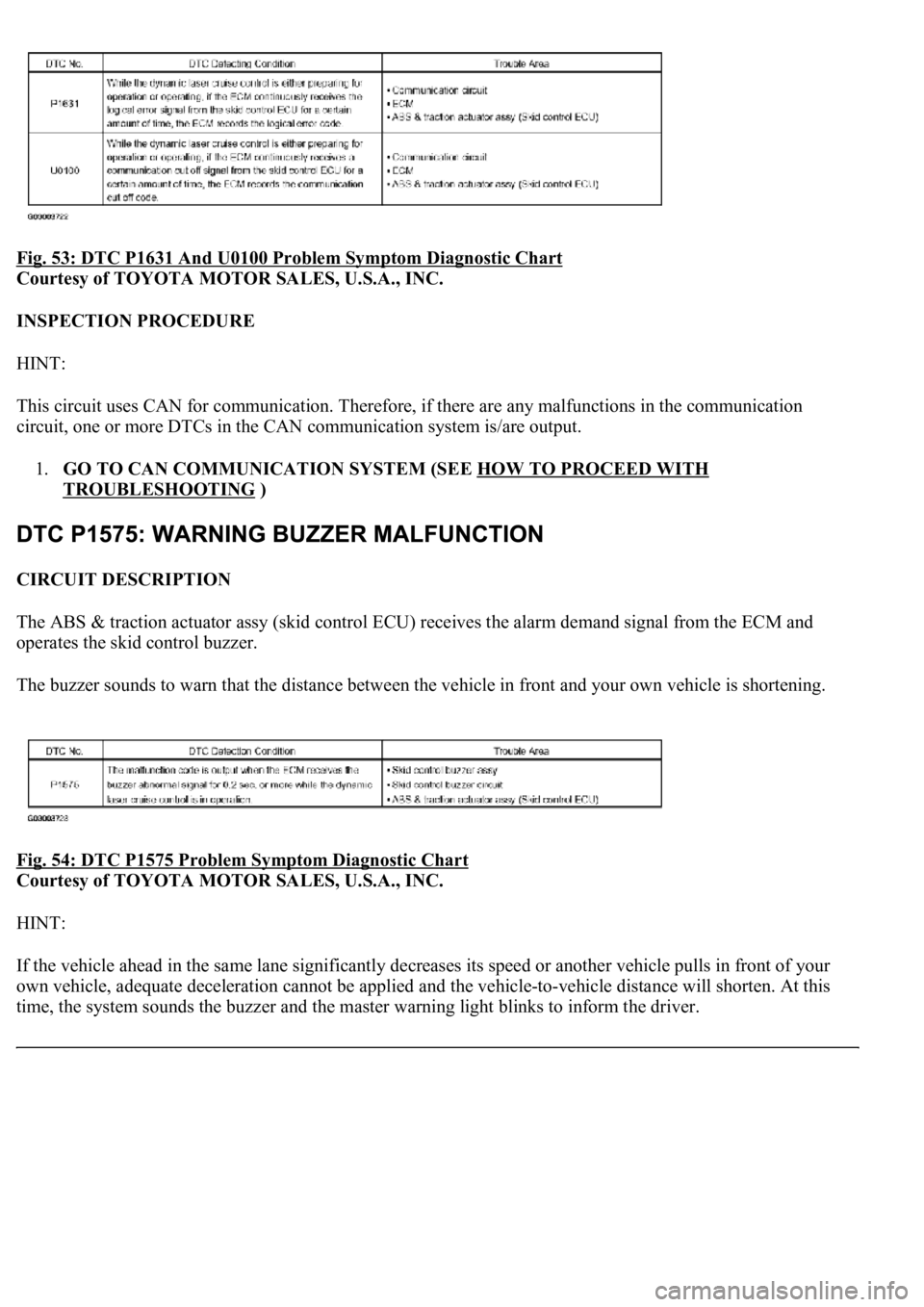
Fig. 53: DTC P1631 And U0100 Problem Symptom Diagnostic Chart
Courtesy of TOYOTA MOTOR SALES, U.S.A., INC.
INSPECTION PROCEDURE
HINT:
This circuit uses CAN for communication. Therefore, if there are any malfunctions in the communication
circuit, one or more DTCs in the CAN communication system is/are output.
1.GO TO CAN COMMUNICATION SYSTEM (SEE HOW TO PROCEED WITH
TROUBLESHOOTING )
CIRCUIT DESCRIPTION
The ABS & traction actuator assy (skid control ECU) receives the alarm demand signal from the ECM and
operates the skid control buzzer.
The buzzer sounds to warn that the distance between the vehicle in front and your own vehicle is shortening.
Fig. 54: DTC P1575 Problem Symptom Diagnostic
Chart
Courtesy of TOYOTA MOTOR SALES, U.S.A., INC.
HINT:
If the vehicle ahead in the same lane significantly decreases its speed or another vehicle pulls in front of your
own vehicle, adequate deceleration cannot be applied and the vehicle-to-vehicle distance will shorten. At this
time, the s
ystem sounds the buzzer and the master warning light blinks to inform the driver.
Page 2498 of 4500
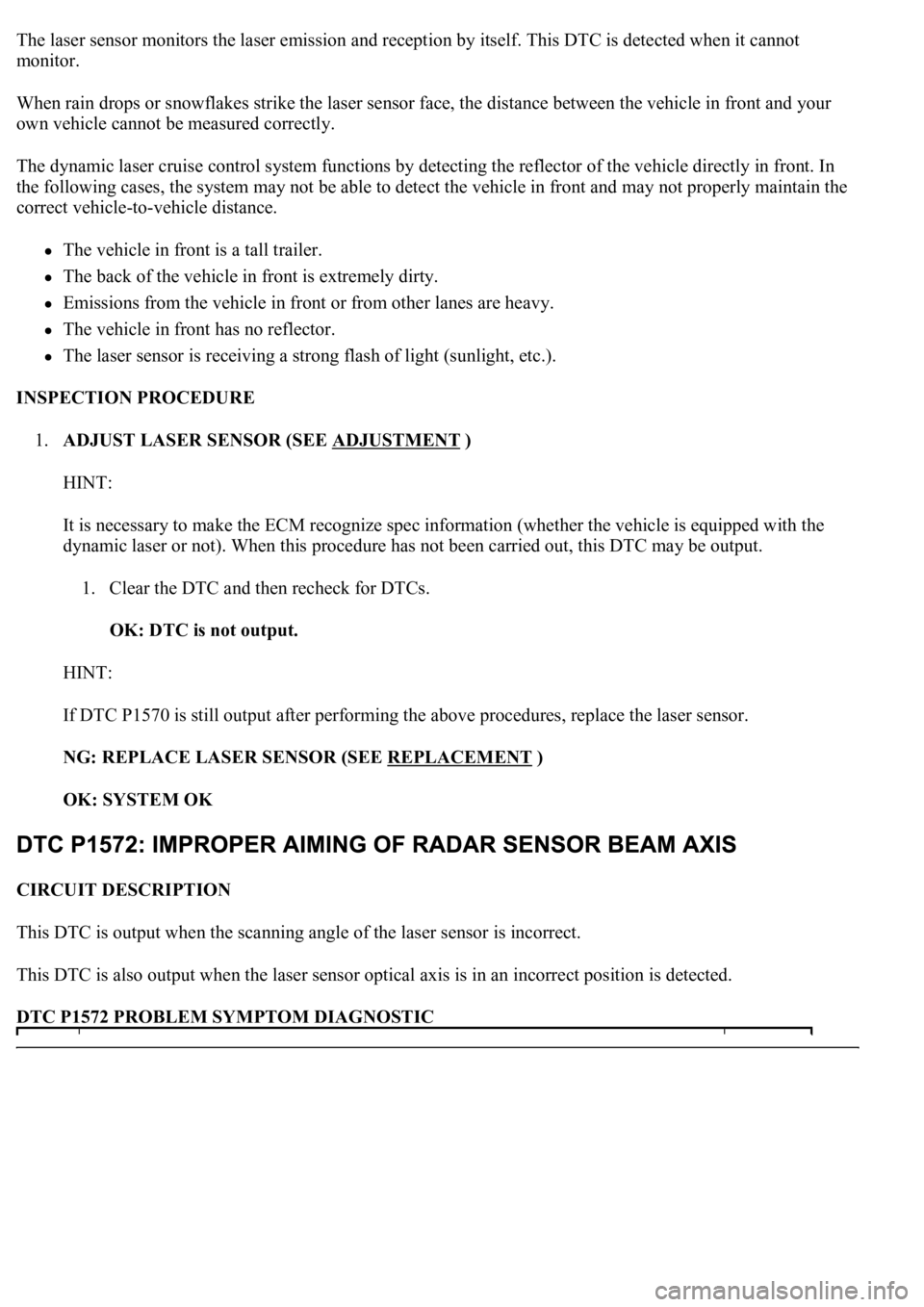
The laser sensor monitors the laser emission and reception by itself. This DTC is detected when it cannot
monitor.
When rain drops or snowflakes strike the laser sensor face, the distance between the vehicle in front and your
own vehicle cannot be measured correctly.
The dynamic laser cruise control system functions by detecting the reflector of the vehicle directly in front. In
the following cases, the system may not be able to detect the vehicle in front and may not properly maintain the
correct vehicle-to-vehicle distance.
The vehicle in front is a tall trailer.
The back of the vehicle in front is extremely dirty.
Emissions from the vehicle in front or from other lanes are heavy.
The vehicle in front has no reflector.
The laser sensor is receiving a strong flash of light (sunlight, etc.).
INSPECTION PROCEDURE
1.ADJUST LASER SENSOR (SEE ADJUSTMENT
)
HINT:
It is necessary to make the ECM recognize spec information (whether the vehicle is equipped with the
dynamic laser or not). When this procedure has not been carried out, this DTC may be output.
1. Clear the DTC and then recheck for DTCs.
OK: DTC is not output.
HINT:
If DTC P1570 is still output after performing the above procedures, replace the laser sensor.
NG: REPLACE LASER SENSOR (SEE REPLACEMENT
)
OK: SYSTEM OK
CIRCUIT DESCRIPTION
This DTC is output when the scanning angle of the laser sensor is incorrect.
This DTC is also output when the laser sensor optical axis is in an incorrect position is detected.
DTC P1572 PROBLEM SYMPTOM DIAGNOSTIC
Page 2503 of 4500
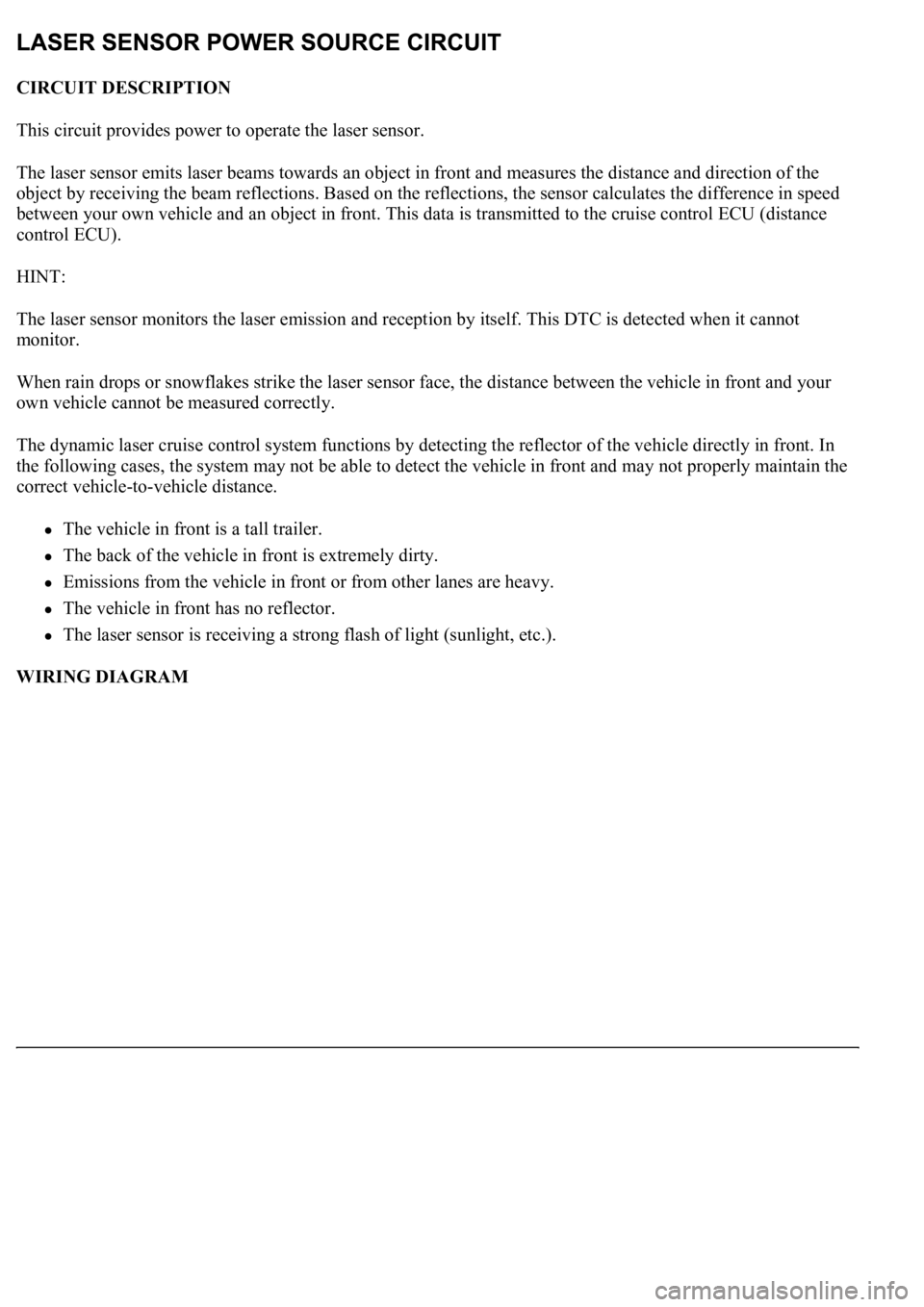
CIRCUIT DESCRIPTION
This circuit provides power to operate the laser sensor.
The laser sensor emits laser beams towards an object in front and measures the distance and direction of the
object by receiving the beam reflections. Based on the reflections, the sensor calculates the difference in speed
between your own vehicle and an object in front. This data is transmitted to the cruise control ECU (distance
control ECU).
HINT:
The laser sensor monitors the laser emission and reception by itself. This DTC is detected when it cannot
monitor.
When rain drops or snowflakes strike the laser sensor face, the distance between the vehicle in front and your
own vehicle cannot be measured correctly.
The dynamic laser cruise control system functions by detecting the reflector of the vehicle directly in front. In
the following cases, the system may not be able to detect the vehicle in front and may not properly maintain the
correct vehicle-to-vehicle distance.
The vehicle in front is a tall trailer.
The back of the vehicle in front is extremely dirty.
Emissions from the vehicle in front or from other lanes are heavy.
The vehicle in front has no reflector.
The laser sensor is receiving a strong flash of light (sunlight, etc.).
WIRING DIAGRAM
Page 2519 of 4500
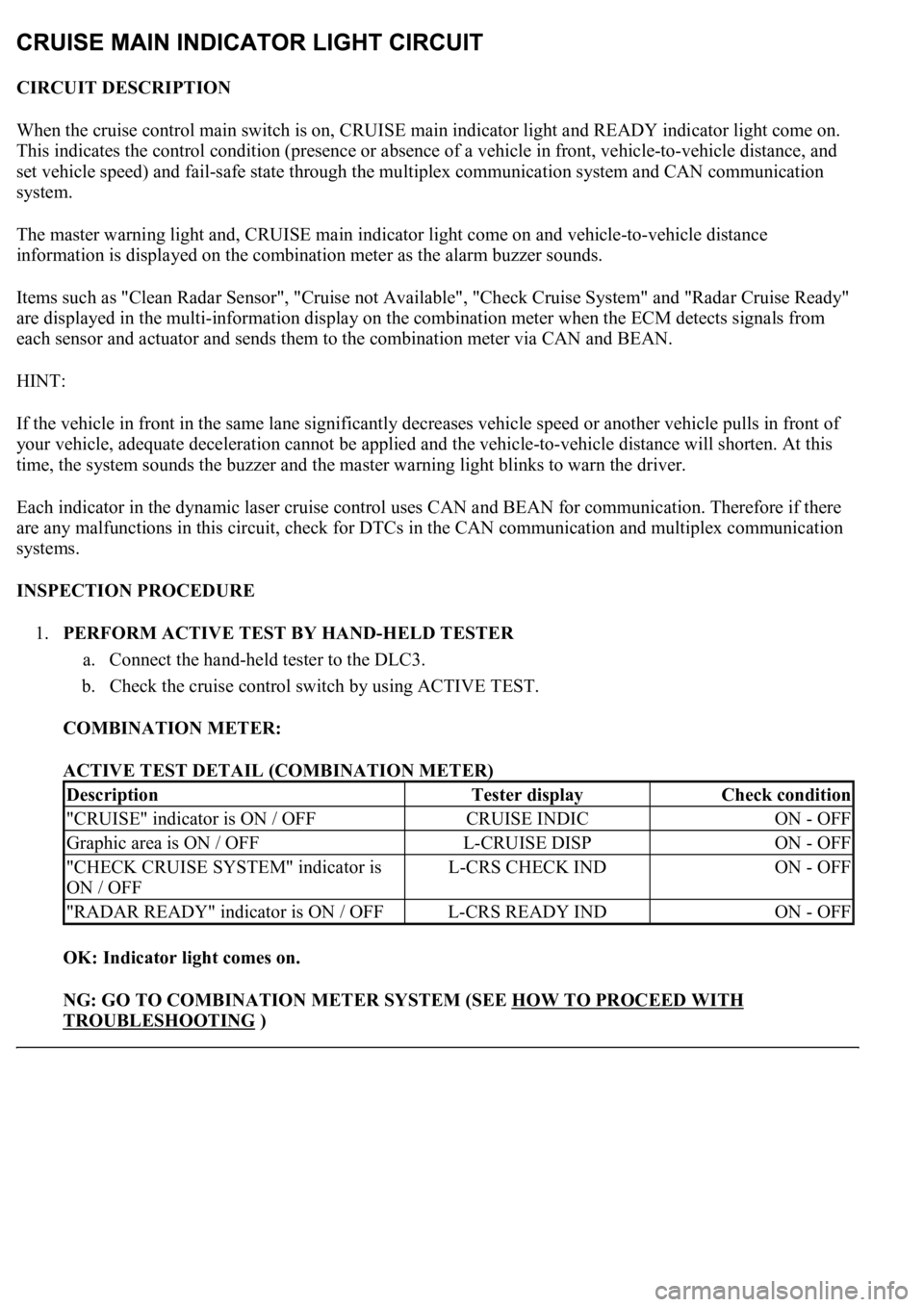
CIRCUIT DESCRIPTION
When the cruise control main switch is on, CRUISE main indicator light and READY indicator light come on.
This indicates the control condition (presence or absence of a vehicle in front, vehicle-to-vehicle distance, and
set vehicle speed) and fail-safe state through the multiplex communication system and CAN communication
system.
The master warning light and, CRUISE main indicator light come on and vehicle-to-vehicle distance
information is displayed on the combination meter as the alarm buzzer sounds.
Items such as "Clean Radar Sensor", "Cruise not Available", "Check Cruise System" and "Radar Cruise Ready"
are displayed in the multi-information display on the combination meter when the ECM detects signals from
each sensor and actuator and sends them to the combination meter via CAN and BEAN.
HINT:
If the vehicle in front in the same lane significantly decreases vehicle speed or another vehicle pulls in front of
your vehicle, adequate deceleration cannot be applied and the vehicle-to-vehicle distance will shorten. At this
time, the system sounds the buzzer and the master warning light blinks to warn the driver.
Each indicator in the dynamic laser cruise control uses CAN and BEAN for communication. Therefore if there
are any malfunctions in this circuit, check for DTCs in the CAN communication and multiplex communication
systems.
INSPECTION PROCEDURE
1.PERFORM ACTIVE TEST BY HAND-HELD TESTER
a. Connect the hand-held tester to the DLC3.
b. Check the cruise control switch by using ACTIVE TEST.
COMBINATION METER:
ACTIVE TEST DETAIL (COMBINATION METER)
OK: Indicator light comes on.
NG: GO TO COMBINATION METER SYSTEM (SEE HOW TO PROCEED WITH
TROUBLESHOOTING )
DescriptionTester displayCheck condition
"CRUISE" indicator is ON / OFFCRUISE INDICON - OFF
Graphic area is ON / OFFL-CRUISE DISPON - OFF
"CHECK CRUISE SYSTEM" indicator is
ON / OFFL-CRS CHECK INDON - OFF
"RADAR READY" indicator is ON / OFFL-CRS READY INDON - OFF